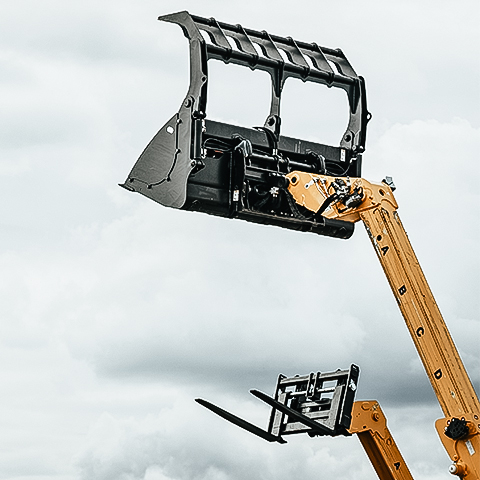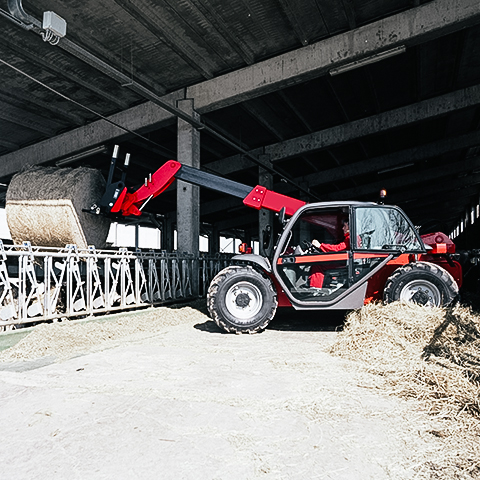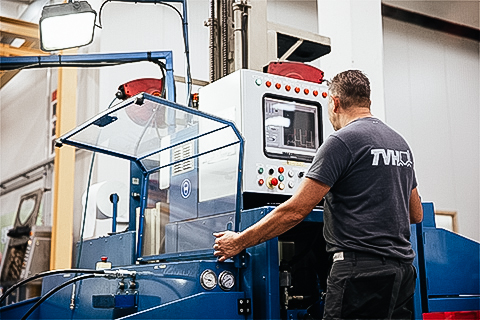Why telehandlers are shifting towards agriculture

Telehandlers are versatile machines that can be equipped with various attachments. They are used in construction, but can also increasingly be found in agriculture. Regardless of their application, it is always essential to subject telehandlers to thorough maintenance. For that, you require a reliable parts supplier, like TVH. Not only do we have all the telehandler parts you need, we also have many skilled experts who can provide technical support. One of those experts is Claudio Giordano. We borrowed an hour of his time for a chat about telehandlers.
About the expert
Claudio Giordano has been working for TVH since 2016. He’s active as market management specialist for telehandlers and as global product manager for CAM Attachments. Before joining TVH, he worked for a major telehandler brand as a sales and marketing manager (first for the machines, later for their attachments) for a little over a decade. This makes him the perfect person to dive into the world of telehandlers with.
The versatility of telehandlers

Fixed or rotating
Claudio Giordano: “Telehandlers or telescopic handlers are used to lift and move goods. They are divided into two families: fixed-frame and rotating-frame. The boom of fixed-frame (or generic, or frontal) telehandlers can only lift and extend. Rotating-frame telehandlers, on the other hand, are equipped with an agile turret. Either the machine has a turning circle of 360°, or it can turn 180° to the left and right. The former is popular in construction, since that turning circle is comparable to the one of mobile elevating work platforms and cranes.”
Types of steering
“Although fixed and rotating telehandlers have different characteristics, both versions are highly manoeuvrable, offering different types of steering. First there is front wheel steering, which means that only the front wheels turn. With four-wheel steering, both the front and the rear wheels turn, but in opposite directions. A third kind of steering is lateral steering, which means that all four wheels rotate in the same direction, allowing the equipment to move sideways. That manoeuvrability is ideal for working in confined spaces.”
Various attachments
“Telehandlers are multi-purpose and can be used as a complementary machine for many activities. They have an extending boom, allowing them to lift loads very high. In addition, they can easily be equipped with different types of attachments, adapting them to various situations.”
Shift towards agriculture
“In the past, telehandlers were mainly used in construction”, Claudio continues. “But that sector suffered major losses in 2008 and 2009 due to the global financial crisis. Construction companies had no budget left to invest in new equipment, hence telehandler manufacturers started to focus on the agricultural sector instead. And that shift wasn’t far-fetched, since the adaptability of telehandlers makes them practical and time-efficient for farming.”

Construction versus agriculture
“There are some differences between telehandlers for construction and those for agriculture, such as a difference in speed. Since there are often many people working together on a site, safety is of the essence in construction and the maximum speed of equipment is limited to 20-25 km/h. In agriculture, fields are less crowded and the distance to the farm can be great, so speed is crucial. That is why farming equipment can often reach a speed of 40-45 km/h.
More significant is the difference in the power of the thermal engine, which has an impact on the hydraulic power and pulling power of the machine. Because of the various types of attachments that agricultural telehandlers are often equipped with, they need adequate hydraulic power at the head of the boom. And since they are often used to tow heavy trailers, telehandlers in agriculture also require a lot of pulling power.”
| Construction | Agriculture | |
|---|---|---|
| Common type | rotating-frame telehandler with 360° turning circle | fixed-frame telehandler |
| Maximum speed | 20-25 km/h | 40-45 km/h |
| Power thermal engine | Lower requirements | Higher requirements |
“But overall, the differences between the two industries aren’t huge. After all, manufacturers want to standardise their telehandlers as much as possible. This also means that as a parts dealer, TVH can always offer the same great service.”
Machines in motion
“However, there is more movement in the world of telehandlers than just the shift towards agriculture”, Claudio nuances. “More and more telehandler brands are developing electric models. Those models are mainly targeted at the agri world, where they can be used in closed environments such as barns, hangars and greenhouses. Also noteworthy is the increasing number of alliances between tractor brands and telehandler brands. Because of the versatility of telehandlers and their popularity in agriculture, tractor brands make great efforts to add them to their portfolio.”
TVH, your partner for telehandler parts
“It is crucial to keep a telehandler in tiptop shape”, Claudio points out. “General or periodic maintenance of a machine, such as an oil and filter change, should happen about every 500 working hours. Consumable parts, like brake pads and bushings, need to be replaced every 1 000 to 2 000 hours. But we have noticed that in construction, people easily lose track of when a telehandler last received maintenance. After all, construction equipment often has different daily users, leading to a higher amount of unexpected breakage.”
Suitable for many brands
“Luckily, we at TVH can help with that! We provide parts and accessories suitable for a wide range of brands, such as Ausa, Bobcat, Case, Caterpillar, CLAAS, Deutz-Fahr, Dieci, Faresin, Genie, Haulotte, JCB, JLG, John Deere, Kramer, Komatsu, Liebherr, Magni, Manitou, Massey Ferguson, Merlo, New Holland, Terex, Weidemann, … Is your machine’s brand not in this list? Don’t worry! It’s very likely that we can still offer the right part.”
Parts for all telehandlers
“We have all the parts one could possibly need, including engine parts, transmission parts, electronic boards, hydraulic parts, tyres, … If you’re not sure what part suits best, our skilled employees can provide professional service and will help with all your technical questions. Once we have found what part is needed, we ship it to you within 48 hours, and if possible even within 24 hours! In that way, the standstill of your telehandler is kept to a minimum.”

Attachments for telehandlers
“But that’s not all. With our own brand CAM Attachments, we can provide you with a wide range of high-quality attachments”, Claudio adds. “Those attachments can be used for all types of machines – not only for telehandlers – and in various industries. For the agricultural sector, we have bale grippers, manure forks, … Some of the attachments that can be useful for construction (but not limited to) are buckets, crane jibs, forks, concrete block clamps, … Whatever your machine’s needs, we can help with the right attachment!”
Ready to order?
Do you want to access more than 400 000 known references for telehandlers?
- Go to the MyPartsFinder search function on MyTotalSource
- Enter your machine’s details
- Find the parts you need